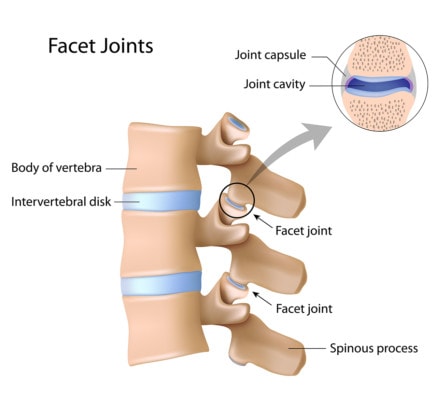Low Back Facet Joints and Stem Cells?

Alila Medical Media/Shutterstock
Can stem cells help patients with low back facet joints pain? The answer is that it depends. If the facet joint was damaged due to trauma (more common with neck facet joints) then we’ve seen good results. However, much of low back facet pain is degenerative and thus due to longstanding wear forces. To review, the facets in the low back are the joints that help to connect the back of the vertebrae at each level. The normal curvature in the back helps distribute the load of the body evenly between the front of the spine (discs) and the back of the spine (facet joints). If you look at the drawing above, notice the facet joints are in the back of the spine (front is to the left in this picture). Recently I examined a patient in clinic who had 6 months of relief from traditional steroid facet injections that were performed because his MRI showed swollen facet joints. This worked very well for awhile, but then the pain came back with a vengeance. Why? Well the first reason is simple, while steroids are potent anti-inflammatories, they also chew up cartilage, so when the anti-inflammatory effect wore off, the facet joints were likely worse off because of the steroid. The second reason the pain returned may not be as readily apparent, but gets down to the basics of our orthopedics 2.0 approach (see our practice’s e-book for more information). Notice above that this patient’s spine looks more like the one on the right, where there’s a high sacral angle. This means that his sacrum (the triangle at the bottom of the spine) is oriented more horizontally than most. This can happen when the psoas muscles are too tight or for any number of other reasons. As a result, his spine bends backward on itself, trying to compensate. This causes more pressure on the facet joints which are wearing out. So if we place magic stem cells in these facet joints, even if they work to shore up his degenerating cartilage, the patient’s pain will just come back because we did nothing to help his high sacral angle. While we’re just getting started with this patient, the implications of his bio-mechanics on what we can do for him with stem cells is clear. In order to save a joint not only do you need to know how to help that joint, but you also need to know how it got that way in the first place.

NOTE: This blog post provides general information to help the reader better understand regenerative medicine, musculoskeletal health, and related subjects. All content provided in this blog, website, or any linked materials, including text, graphics, images, patient profiles, outcomes, and information, are not intended and should not be considered or used as a substitute for medical advice, diagnosis, or treatment. Please always consult with a professional and certified healthcare provider to discuss if a treatment is right for you.
